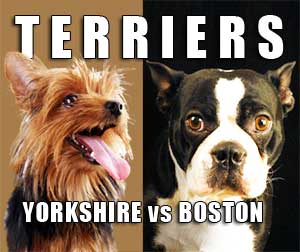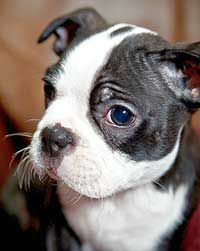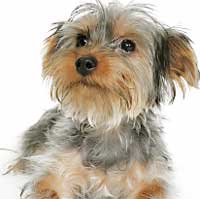
Terrier vs. Terrier -The Yorkshire and Boston: Up Close and Personal
Posted by admin on June 16, 2010
There is a proverb that says, “A rose is a rose is a rose.” It may be tempting to think the same is true for any animal with “terrier” in its name, but nothing could be further from the truth. Just look at the vast differences between the sturdy Boston Terrier and the more homely Yorkshire Terrier.
Boston Terrier
The Boston Terrier, classified by the American Kennel Club in the non-sporting group, is the result of cross-breeding the Old English Bulldog and the English White Terrier. Despite the British names of their ancestors, Boston Terriers originated in the United States, one of the few breeds native to America. Originally bred to fight in the pits in Boston, they are now used as companion dogs.
Boston Terriers are often very cuddly and can be socialized to enjoy children, other dogs, and even other non-canine pets in the home. This breed is desirable for those who live in close quarters, as they generally bark only when necessary. The popularity of the Boston peaked in the 1920’s and has declined since then. They are very easy to train, as they have an innate desire to please. These active dogs need lots of exercise, but they can overheat very quickly due to the structure of their muzzle. Boston Terriers must be kept primarily indoors, as they cannot deal with temperature extremes outside.
Yorkshire Terrier
In contrast, the Yorkshire Terrier is a member of the toy class. Yorkshire Terriers originated in the Yorkshire and Lancashire regions of England in the mid-nineteenth century. Miners and mill workers came to this rugged area of northern England, bringing their terriers to keep vermin under control in their homes, as well as in the mines and mills where they worked.
The skills of their dogs were shown off in “rat pits”, where the dog who killed the most rats in the shortest time period was declared the winner. The exact ancestry of the breed is not known, but it is thought to include various terrier breeds from Scotland including the Clydesdale, Paisley, Black and Tan, Skye, and Waterside terriers. The foundation sire of the breed was Huddersfield Ben, a dog born in 1865 in the town of Huddersfield, in the county of Yorkshire. Although he died at the young age of six, he won more than 70 prizes at dog shows.
The terrier ancestry results in Yorkshire Terriers being intelligent, independent, and confident. This confidence may get them into trouble, as they often do not realize they are much smaller than other dogs with whom they may choose to play. The Yorkshire Terrier loves to play with other dogs of all sizes, but may try to assert himself as the alpha dog in the pack. In addition, the Yorkshire Terriers’ independence makes them harder to housebreak than some other breeds. Yorkshire Terriers often bark at strangers and may become withdrawn and aloof around new people.
The Yorkshire Terrier has been the second most popular dog breed in the United States in recent years, with only Labrador Retrievers being registered more often with the American Kennel Club. Yorkshire Terriers enjoy the company of their human housemates, but may prefer to rest in an out-of –the-way corner when play time is over.
Scientific studies have confirmed the intelligence of the Yorkshire Terrier. Dr. Stanley Cohen, a researcher in the field of animal intelligence ranked the breed 27th out of 132 breeds tested. Among his findings: an average Yorkshire Terrier can learn a new command after just 15 repetitions. (Many parents may say that this is faster than their children!)
As far as appearance, the Boston Terrier and the Yorkshire Terrier are immensely different. Boston terriers have short hair, erect ears, a short muzzle without wrinkles, a square face, and a short tail. They are 15 – 17 inches high and weigh somewhere between 10 and 25 pounds.
Yorkshire Terriers are remarkable primarily for their long, silky hair. The hair grows continuously and is often cut to floor length or shorter to allow the dog greater mobility and to ease grooming requirements. The breed standard for Yorkshire Terriers does not specify a height, but does state that the maximum weight should be no more than seven pounds. Yorkshire Terriers have a small, flat head with erect, V-shaped ears, and their tails are normally docked to a medium length. The hair must be straight, glossy, fine, and silky. For showing, it is generally parted from the nape of the neck to the base of the tail and allowed to fall to the floor on both sides of the dog. The hair must be trimmed short on the tips of the ears to allow the ears to stand erect. The topknot is generally tied with a ribbon, or parted and tied with two ribbons.
Boston Terriers have markings resembling a tuxedo, with a white chest, and muzzle. The white coloring extends halfway up the legs. In addition, there is typically a white blaze between the eyes. The remainder of the dog may be brindle, black, and / or seal, a shiny black color containing red highlights when seen in the sun. The preferred color is brindle, but the other colors are acceptable under the breed standards.
Yorkshire Terriers are black and tan at birth, becoming steel blue with a tan head, chest, and legs, as they age. The Yorkshire Terrier does not have an undercoat and carries very little dander, making it ideal for those owners who may have allergic reactions to pets.
Although neither breed sheds excessively, grooming a Yorkshire Terrier is much more labor-intensive than grooming a Boston. To keep a Yorkshire Terrier in show condition requires long hours of brushing each day. Between shows, the long hair may be oiled and wrapped in tissue paper, but must be washed and re-oiled weekly. In contrast, the Boston can be brushed weekly, just enough to bring the skin’s natural oils to the surface and lift out any dead or broken hair.
Each of the two breeds has some significant potential health issues of which a breeder or owner must remain aware. Dogs of either breed typically live somewhere between 12 and 15 years. Although not a cause for major concern, Boston Terriers are prone to snoring. Their short, pushed-in muzzles and elongated soft palates may cause some degree of airway obstruction, resulting in this annoying, but non-life-threatening symptom. Boston Terriers may also develop flatulence, a condition which can typically be controlled by feeding high quality dog food with no table scraps. Boston Terriers are also susceptible to juvenile cataracts, clouding the eyes between 8 and 12 weeks of age. Perhaps most serious, Boston Terriers are prone to hypothyroidism, a condition in which the thyroid gland in the neck underperforms causing obesity, joint problems, infertility and heart disease.
Yorkshire Terriers are often seen in veterinary clinics with genetic problems ranging from Legg-Perthes disease to distichiae to luxating patellae. In Legg-Perthes disease, poor circulation around the hip joint causes deterioration of the top of the thigh bone. This occurs while the dog is quite young, typically between 5 and 8 months of age. Distichiae are eyelashes that grow in the wrong spot, causing eye irritation even to the point of scarred corneas. Luxating patellae are kneecaps that slip sideways due to weak knee ligaments combined with shallow patellar grooves. These grooves are designed to hold the kneecaps in place, but when they are too shallow, the kneecaps can slide out of the grooves.
Another disease common to the Yorkshire Terrier is a porto-systemic shunt. Under normal circumstances, the liver removes toxins from the blood, protecting the other organs of the body from damage. In this condition, the portal vein is malformed, allowing blood to bypass the liver and contaminate the brain, heart, and other vital organs.
Finally, Yorkshire Terriers may experience hypoplasia of dens, a deformity of the second cervical vertebra. The malformation causes spinal cord damage and can produce symptoms ranging from neck pain to quadriplegia.
Although not a genetic disease, a common problem in Yorkshire Terriers is stomach upset, including diarrhea and vomiting. The breed is known for having a delicate digestive system. They are picky eaters and will only eat foods they enjoy. However, enjoyable foods outside of their regular diet can result in gastric distress.
Boston Terriers have been owned by Helen Keller and United States President Warren G. Harding. The breed is the state dog of Massachusetts, where Rhett the Boston Terrier is the mascot of Boston University.
Yorkshire Terriers have been owned by Joan Rivers, Justin Timberlake, Jeff Gordon, Paris Hilton, and Britney Spears. The dog has been featured on the hit television series Green Acres, as well as in the movies A Fish Called Wanda and High School Musical 2.
As we have seen, the Boston Terrier and Yorkshire Terrier may share a surname, but they are immeasurably different dogs. They have been bred for historically different reasons and have temperaments suited to these earlier functions. Their care varies and they have distinctive health concerns. Depending on the prospective owner’s needs and desires, an intelligent choice between the two breeds can be made based on the information presented in this article.




